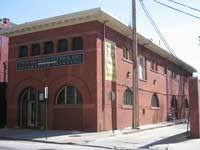ART | Visual Arts

MATCH GAME: Bill Schmidt's "One Of These Things Is Not Like The Other."
Bill Schmidt: Outside of Time
At Paperwork Gallery through May 2
By Bret McCabe
HANGING ANYTHING ON THE WALL often transforms it into the purely decorative. Old street signs, antique stovetop burners, castoff manhole covers, a well-weathered garden trowel, old magazines and record covers--one person's castoff/thrift-store donation is another person's shabby chic to install above that precious sofa found at that very cute little secondhand store around the corner from the coffee shop and sex-positive marital aids shop. Such is the process of object commodification: turning meaningful things into inert objects.
Just don't tell that to Bill Schmidt. The director of the post-baccalaureate program at the Maryland Institute College of Art has the audacity to allow his hanging sculptures to vibrate with possibilities, waiting to become whatever they may be. Lining the back wall of the Paperwork Gallery--the newish space opened last December by local artists Dana Reifler and Cara Ober on the first floor of East Preston Street's Midtown Yoga Center--hang a small array of Schmidt's sculptures-qua-contraptions. These five pieces--combinations of wood, found objects, paint, and exquisite technique--are all tall and thin, starting at about eye level and extending toward the floor. Bluntly named--the tusklike "Not for Nothing," the totemic "Zig-Zag Wanderer," the cagelike "Pendule"--and yet quite sensually constructed, the pieces read like curious contradictions. Think some combination of extravagant Shaker furniture and highly specialized primitive tool. They start to feel like something you might find hanging on the wall of a veteran Nova Scotia seaman, a beautiful instrument intended for pragmatically deadly survival, or something busted out after a catch in which to smoke celebratory tobacco.
These are the sorts of works for which Schmidt is best known. The majority of the works on view in Outside of Time, though, are intimate abstract paintings completed over the past few years, following a residency in Rochefort-en-Terre in the Brittany region of France that, reportedly, rekindled his interest in painting. The nine paintings exhibited are all tight compositions, approximately the size of a printed page, and are rendered in gouache and colored pencil on paper. The colors lean toward the warmer hues (yellows, reds, and their orange progeny), and even when Schmidt turns to the blues, greens, and their aqua splashes, it's more the airy effect of the sky rather than the enigmatic depth of the opaque sea.
Schmidt's abstract vocabulary here is what's disarming. Wily, witty, squishy, biomorphic, so precise in its ordered disarray, it feels a little too endearingly nostalgic, like the not so distant past's imagination of the far-off future. Think 1940s and '50s advertising, graphic design, and marquee lights: rods that end in bulbous globes, sharp angles that jut into elegantly smooth curves, regular polygons whose curves are bent into stiff acute angles and become silhouettes of Flash Gordon comic-strip spaceships, soft bubblelike circles forming chains like a cocktail glass' trail across Formica. Throughout, Schmidt's hand is assuredly expert, and his life experience--titles that allude to player-piano composer Conlon Nancarrow or display his subtle wit, such as "Piecemeal Coexistence"--is integrated into the works with austere modesty.
All of the elements are at play in Schmidt's sculptures, just in different degrees. As evidenced in his five sculptures and an assortment of found-object assemblages also on view, Schmidt's otherworldly ideas aren't sci-fi or some not-yet-possible; they seek the still-possible from the possibly forgotten. Subtle implication is more powerful a push than realized imagination in his works.
For his 1988 film Dead Ringers David Cronenberg conceived surgical instruments for "operating on mutant women," a series of formidably indelicate metal instruments whose mere suggestions of potential bodily use is more threatening than anything that the director could depict on screen. Schmidt's sculptures are similar sorts of mental potential-energy time bombs, as his found-object assemblages read like excavations from an archeological site that hint some early society required tools for crushing, cutting, and possibly even prostate stimulation.
The new paintings, though, aren't as richly kinetically charged. Their overall vibe is whimsical and effervescent, both perfectly fine attitudes for such keenly nostalgic work. Let's just not turn molehills into mountains--viz., an April 19 Roberta Smith article in The New York Times, which observed that small abstraction is "in"--as evidenced by a recent quartet of small abstraction solo shows and bulwarked by the idea of getting small being, perhaps, a form of ideological dissent against the grandiose spectacle of the large panel. Paul Klee is the name dusted off anytime "small" and "abstraction" enters the same discussion, a comparison born more of size than of content, too often ignoring the rapier sociopolitical observations Klee invested in his intimate and deceptively inviting paintings. (The ephemerally organic vocabulary of Toni LaSelle would be a better reference point for Schmidt's paintings here.) Size does matter, natch, but it doesn't define the work; paintings aren't wall-mounted tchotchkes. They do, however, look great hung on the wall.
- Bret McCabe

No comments:
Post a Comment